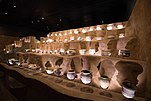Neolithic
The Neolithic period of Chinese history began around 10,000 BC, and is typically split into three: early (10,000–7,500 BC), middle (7,500–5000), and late (5000–3000 BC) periods, and sometimes a fourth (3000–2000 BC). [1] During the Neolithic, the first Chinese civilizations formed: the northern Yellow River civilizations and southern Yangtze civilizations ( lit. 'long river civilization'), named for rivers of the same name. [2] Alongside other cradle of civilizations, China underwent a major Agricultural Revolution, [3] seeing cultivation of millet by 8000 BC and rice by 7000 BC in North and South China respectively. [2] [a] Other early cultivations include various tuber plants by 12,700 BC and soybean by 7000 BC, while wheat, barley and oats appeared much later, around 3000–2000 BC, probably from Central Asian importation. [8]
Unlike other ancient societies, China societies may have developed pottery before agriculture, suggested by remains from the Paleolithic Xianren Cave (18000–7000 BP). [9] Neolithic sites are often differentiated by their remaining pottery artifacts; [1] .... The earliest of these Nanzhuangtou (10,000) ...
Later in the Neolithic, c. 3500–2000, the use of jade became widespread in the Hongshan and Liangzhu cultures. [1] A staple of Chinese culture, the dominance of jade has led some scholars to characterize its formative period as a "Jade Age". [1]
[Writing]
The Jiahu site is one of the best preserved early agricultural villages (7000 to 5800 BC).
At Damaidi in Ningxia, 3,172 cliff carvings dating to 6000–5000 BC have been discovered, "featuring 8,453 individual characters such as the sun, moon, stars, gods and scenes of hunting or grazing", according to researcher Li Xiangshi. Written symbols, sometimes called proto-writing, were found at the site of Jiahu, which is dated around 7000 BC, [10] Damaidi around 6000 BC, Dadiwan from 5800 BC to 5400 BC, [11] and Banpo dating from the 5th millennium BC.
With agriculture came increased population, the ability to store and redistribute crops, and the potential to support specialist craftsmen and administrators, which may have existed at late Neolithic sites like Taosi and the Liangzhu culture in the Yangtze delta. [12]
The cultures of the middle and late Neolithic in the central Yellow River valley are known respectively as the Yangshao culture (5000 BC to 3000 BC) and the Longshan culture (3000 BC to 2000 BC). Pigs and dogs were the earliest domesticated animals in the region, and after about 3000 BC domesticated cattle and sheep arrived from Western Asia. Wheat also arrived at this time, but remained a minor crop. Fruit such as peaches, cherries and oranges, as well as chickens and various vegetables, were also domesticated in Neolithic China. [13]
References
Notes
- ^ The cultivations included Setaria italica and Panicum miliaceum millet, as well as Oryza sativa rice, both the indica and japonica variants. [4] Traditionally, scholars largely that rice was first cultivated in near northern Yellow River and millet near the southern Yangtze, divided by the Huai River. [5] [6] There is considerable dispute on wether the crops originated together or seperately. [7]
Citations
- ^ a b c d Wilkinson 2018, p. 737.
- ^ a b Barker & Goucher 2015, p. 325.
- ^ Chang 1999, pp. 42–44.
- ^ Li & Chen 2012, pp. 75–85.
- ^ He et al. 2017, p. 2.
- ^ Chang 1999, pp. 44–46.
- ^ He et al. 2017, pp. 1–3.
- ^ Li & Chen 2012, pp. 85–94.
- ^ Xiaohong Wu 2012, pp. 1696–1697.
- ^ Rincon, Paul (17 April 2003). "'Earliest writing' found in China". BBC News.
- ^ Qiu Xigui (2000). Chinese Writing. English translation of 文字學概論 by Gilbert L. Mattos and Jerry Norman. Early China Special Monograph Series No. 4. Berkeley: The Society for the Study of Early China and the Institute of East Asian Studies, University of California, Berkeley. ISBN 978-1-55729-071-7
- ^ Pringle, Heather (1998). "The Slow Birth of Agriculture". Science. 282 (5393): 1446. doi: 10.1126/science.282.5393.1446. S2CID 128522781. Archived from the original on 1 January 2011.
-
^ Cite error: The named reference
:0was invoked but never defined (see the help page).
Sources
-
Fairbank, John K.;
Twitchett, Denis, eds. (1978–2020).
The Cambridge History of China. Cambridge:
Cambridge University Press.
- Chang, Kwang-chih (1999). "China on the Eve of the Historical Period". In Loewe, Michael; Shaughnessy, Edward L. (eds.). The Cambridge History of Ancient China: From the Origins of Civilization to 221 BC. Cambridge: Cambridge University Press. ISBN 978-0-521-47030-8.
- He, Keyang; Lu, Houyuan; Zhang, Jianping; Wang, Can; Huan, Xiujia (7 June 2017). "Prehistoric evolution of the dualistic structure mixed rice and millet farming in China". The Holocene. 27 (12): 1885–1898. Bibcode: 2017Holoc..27.1885H. doi: 10.1177/0959683617708455. S2CID 133660098. Archived from the original on 20 November 2021. Retrieved 23 January 2019.
- Li, Liu (2009). The Chinese Neolithic: Trajectories to Early States. Cambridge: Cambridge University Press. ISBN 978-0-511-48962-4.
- Li, Liu; Chen, Xingcan (2012). The Archaeology of China: From the Late Paleolithic to the Early Bronze Age. Cambridge: Cambridge University Press. doi: 10.1017/CBO9781139015301. ISBN 978-1-139-01530-1.
- Shelach-Lavi, Gideon (2015). The Archaeology of Early China: From Prehistory to the Han Dynasty. Cambridge: Cambridge University Press. ISBN 978-0-521-19689-5. }}
- Wilkinson, Endymion (2018). Chinese History: A New Manual (5th ed.). Cambridge: Harvard University Asia Center. ISBN 978-0-9988883-0-9.
Xiaohong Wu (2012). "Early Pottery at 20,000 Years Ago in Xianrendong Cave, China". Science. 336 (6089). Sciencemag.org: 1696–1700. Bibcode: 2012Sci...336.1696W. doi: 10.1126/science.1218643. PMID 22745428. S2CID 37666548. Retrieved 15 January 2015.



